The Economy Of Ecuador

The economy of Ecuador is the eighth largest in Latin America and the 69th largest economy in the world. Its economy is also ranked 107th most complex economy according to the Economic Complexity Index. Ecuador’s Economy is based on the export of banana, oil, gold, and other agricultural products. Money transfer by thousands of Ecuadorians employed abroad is also an economic booster. Ecuador is the leading exporter of banana in the world while oil export accounts for almost 40% of the public sector revenue. Ecuador’s banking sector has made great strides after the 1998-1999 banking sector crises which affected the country’s economic growth and led to the closure of 70% of the financial institutions in the country.
Overview Of The The Economy Of Ecuador
Ecuador’s economy experiences an annual average growth of 6.88%. The country has a nominal GDP of $6.078 trillion and a PPP GDP of $98.9 billion. The annual GDP growth was projected at 0.3% in 2015 which was significantly lower than 2014 (3.7%). The annual consumption variation was estimated at 0.3%. The investment variation plummeted to -2.5% while the industrial production also decreased by 1.4% in 2015. The unemployment rate in the country stands at 5.1% while the inflation rate stands at 3.1% down from 3.7% in 2014. The public debt stands at 33.1%. The poverty declined from 37% to 22% between 2006 and 2014 due to the decrease in the Gini Index.The annual export variation fell in 2015 to -28.7% from 3.5% in 2014 while the export change was -22% during the same period.
Main Export And Export Partners Of Ecuador
Ecuador exported goods worth $18.3 billion in 2015 with major export products including crude oil, banana, processed fish, gold, and Crustacean. Other export products include coffee, shrimp, cocoa, wood, and cut flowers. Ecuador is the biggest banana exporter in the world and also a major exporter of shrimp. The export of flowers and canned fish has grown over the years with Ecuador claiming its stage in the global market. The major export destinations for Ecuador’s products are the US which accounts for 37% of the country’s export. Other export destinations include Chile, Peru, Colombia, Japan, and Russia.
Main Import And Import Partners Of Ecuador
Ecuador is the 69th largest importer in the world and spends $21.5 billion on import goods which include industrial material, refined petroleum, coal, tar oil, lubricants, cars, petroleum gas, and consumer goods. Its top import destinations include the US which accounts for 40% of all its import, Chile 8%, Peru 6.1%, and Panama 5.2%. Other import partners include Russia, Japan, Germany, and Spain.
Challenges To The Economy Of Ecuador
Ecuador’s lack of local currency and the limited fiscal and external cushions has prevented the country from applying macroeconomic policies to address its complex economic problems leading to a decline in the domestic public demand. The government has been forced to cut on public investment and reduce its spending. Ecuador also faces difficulty in adapting its economic structure to the international requirements to achieve the desired strong growth. The economic growth is also threatened by the economic slowdown experienced by the decline in oil prices and stronger US dollars and the restrictions on the movement of goods and capital. Ecuador can only hope that they do not experience the 1998-1999 economic crises if they are to continue on the path of growth and development.







